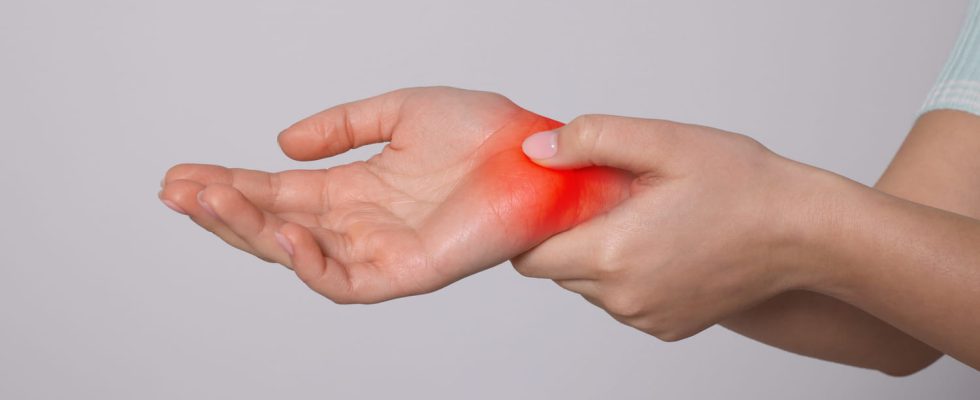Rheumatism is a generic term that refers to all joint damage. It can be osteoarthritis, arthritis or osteoporosis or autoimmune diseases such as rheumatoid arthritis. Symptoms, causes, treatments… We take stock.
rheumatism is a generic term which commonly designates the set illnesses that cause pain or inflammation affecting nearby joints or structures, such as tendons or ligaments. THE symptoms rheumatism is manifested, most of the time, by “mechanical” type pain. Old age is one of the causes rheumatism, but not only. How to diagnose it? What are the treatments to cure rheumatism?
Definition: what is rheumatism?
“Rheumatism refers to all pathologies of the musculoskeletal system. This can be damage to the cartilage, the synovial membrane, but also the tendon or even an intervertebral disc.“, explains from the outset Pr Aleth Perdriger, head of the rheumatology department of the Rennes University Hospital. “Rheumatism” is a rather vague term given to all diseases that cause pain or inflammation affecting nearby joints or structures, such as tendons or ligaments. Rheumatism affects people of all ages, they are not the prerogative of old age.
► Rheumatism and low back pain. At the top, we find low back pain. More than 8 out of 10 people suffer at least once in their life from this back pain usually caused by compression of the sciatic or crural nerve.
► Rheumatism and osteoarthritis. Osteoarthritis is also a very common disorder: approximately 15% of the population is affected of this cartilage destruction. Osteoarthritis of the cervical and lumbar spine are the main osteoarthritis pathologies, followed by osteoarthritis of the hand, knee and hip. The shoulder, elbow, wrist and ankle are rarely affected.
► Inflammatory rheumatism. Rheumatism caused by chronic inflammation is also numerous. rheumatoid arthritis, an autoimmune disease that causes cartilage destruction, affects more than 100,000 people in France. There is also the ankylosing spondylitis or psoriatic arthritis which mainly affects the spine and hips.
► Abarticular rheumatism. Abarticular rheumatism is rheumatism that does not affect the joints. In this category of conditions we find pathologies such asa fibromyalgia, periarthritis, tendonitis (inflammation of the tendons), bursitis (which affects the bursae) or the carpal tunnel syndrome. Certain vasomotor pathologies are also part of abarticular rheumatism such as Raynaud’s disease and Raynaud’s syndrome (blood circulation disorder).
What are the causes of rheumatism?
“Rheumatisms are pathologies partly due to agingHas joint trauma or excessive strain on the cartilage, but also a dysregulation of the immune system and sometimes infections or cancerous growths“, describes the rheumatologist.heredity was also highlighted. However, the exact causes of these disabling pathologies are still unknown.
What are the symptoms of rheumatism?
Rheumatism manifests itself, most of the time, by mechanical pain triggered and aggravated by movement. They subside with rest. Daily pain that does not leave the sick: more than half of them are awakened by their pain. Joint stiffness, swelling and discomfort are also symptoms common to all rheumatic diseases. These symptoms decrease during the day when we move and mobilize the joints.
What examination to detect rheumatism?
The diagnosis of rheumatism is based on a classic medical examination, during which the doctor examines the joints, the range of motion and questions the patient: How long has he been in pain? Which joints are affected? How does the pain manifest? The doctor may also prescribe radiological examinations, CT scan or MRI. In some cases, it is also possible to perform a joint puncture to analyze the fluid in the joint and look for the presence of bacteria or solidified crystals. Of the blood tests can also be performed, in particular to confirm the diagnosis of rheumatoid arthritis.
To treat rheumatism, doctors prescribe analgesics and painkillers such as paracetamolbut also nonsteroidal anti-inflammatory drugs. If this first line of treatment fails, rheumatologists can offer patients corticosteroid injections to relieve inflammation. In the case of chronic inflammatory rheumatism, basic treatments are associated with painkillers in order to control the disease and space out inflammatory crises. Physiotherapy, the practice of a physical activity are non-pharmacological approaches common to all rheumatism because they are essential in the prevention of painful crises: to have less pain, it is necessary to mobilize these joints. Finally, in some cases, surgery may be considered. In particular, it helps to prevent cartilage damage or tendons or repair tendons or replace a destroyed joint with a prosthesis in the case of rheumatoid arthritis. In osteoarthritis patients, surgery is mainly used to place total or partial prostheses of the knee or hip.
Thanks to Professor Aleth Perdriger, head of the rheumatology department at the University Hospital of Rennes.
